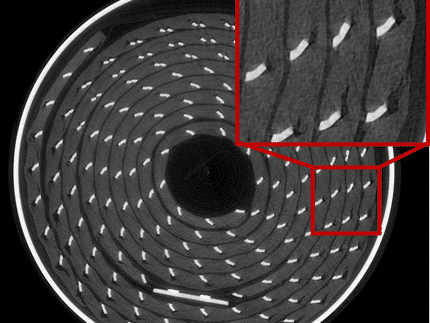Inside the battery in 3D
Powerful X-rays watch solid state batteries charging and discharging
Despite worldwide use of lithium batteries, the exact dynamics of their operation has remained elusive. X-rays have proven to be a powerful tool for peering inside of these batteries to see the changes that occur in real time.

Solid-state batteries are charged and discharged in custom-made hardware designed at Georgia Tech. A smaller, modified version of the cell shown here was used to image these materials during cycling.
Matthew McDowell, Georgia Tech
Using the ultrabright X-rays of the Advanced Photon Source (APS), a U.S. Department of Energy (DOE) Office of Science User Facility at the DOE's Argonne National Laboratory, a research team recently observed the internal evolution of the materials inside solid-state lithium batteries as they were charged and discharged. This detailed 3D information may help improve the reliability and performance of the batteries, which use solid materials to replace the flammable liquid electrolytes in existing lithium-ion batteries.
Using a small (roughly two millimeters wide) cylindrical battery, researchers at APS beamline 2-BM were able to capture 3D images of structural changes during the battery charge and discharge cycles as they happened.
"The main features of this beamline that made this research possible are the high sensitivity and very fast speed," said Francesco De Carlo, group leader with Argonne's X-ray Science division and a co-author on the paper. "The sensitivity helped the team differentiate between phases inside the battery with similar densities, and the speed allowed them to capture the changes inside the battery while the process was evolving."
These clear images revealed how the dynamic changes of electrode materials at lithium/solid-electrolyte interfaces determine the behavior of solid-state batteries. The researchers found that battery operation caused tiny voids -- resolved up to 1-2 microns in size, about 50 times smaller than the width of a human hair -- to form at the interface, which created a loss of contact that was the primary cause of failure in the cells.
"This work provides fundamental understanding of what is happening inside the battery, and that information should be important for guiding engineering efforts that will push these batteries closer to commercial reality in the next several years," said Matthew McDowell, an author on the paper and an assistant professor in the George W. Woodruff School of Mechanical Engineering and the School of Materials Science and Engineering at the Georgia Institute of Technology. "We were able to understand exactly how and where voids form at the interface, and then relate that to battery performance."
The research was reported in Nature Materials.
Other news from the department science

Get the analytics and lab tech industry in your inbox
By submitting this form you agree that LUMITOS AG will send you the newsletter(s) selected above by email. Your data will not be passed on to third parties. Your data will be stored and processed in accordance with our data protection regulations. LUMITOS may contact you by email for the purpose of advertising or market and opinion surveys. You can revoke your consent at any time without giving reasons to LUMITOS AG, Ernst-Augustin-Str. 2, 12489 Berlin, Germany or by e-mail at revoke@lumitos.com with effect for the future. In addition, each email contains a link to unsubscribe from the corresponding newsletter.
























































